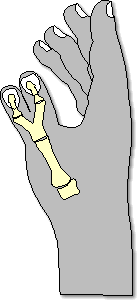| What is it? |
-
Polydactyly refers to extra digits - in the hand, extra fingers or thumbs.
Polydactyly is one of the most common variations on the basic growth pattern
of the hand. There are many different forms of polydactyly, ranging from
-
a small extra bump on the side of the hand,
-
a finger which widens to end in two fingertips,
-
an extra finger which dangles by a thin cord from the hand,
-
a hand which looks normal except that it has a thumb and five fingers,
and
-
an infinite number of other variations.
-
Usually, when a digit has duplicated, each half is somewhat smaller than
usual, and it is common for the joints to angle to the sides, often in
mirror image zig zag directions.
|

 |
|
| What caused it? |
-
Polydactyly occurs in the womb as a detour on the road to developing just
one thumb and four fingers on the hand. In the womb, the new hand starts
out in the shape of a paddle, then splits into separate fingers. Sometimes
the fingers don't split apart enough, and webbed fingers result: syndactyly.
Sometimes a extra split forms and extra fingers result: polydactyly. Syndactyly
and polydactyly are about equally common disorders. Combinations of both
can occur as well - webbed extra fingers. Why does a child have this?
It is not due to anything the mother did during pregnancy - it just happens.
Sometimes these problems are in the genes and can be passed down generation
to generation, but many times there is simply no known explanation.
|
| What can you do to help? |
-
The main decision is to decide whether or not to do anything for the problem.
Certain types of polydactyly are associated with other birth related problems
elsewhere in the body, and it is a good idea to have an evaluation for
this reason alone. Surgery for polydactyly is usually best done in the
first few years of life so that the look, feel and function of the corrected
hand is the most natural for the child.
|
| What can a therapist do to help? |
-
A hand therapist can help with some problems before and after surgery,
tailored to the individual problem and the temperament of the child, but
some children proceed through their surgery and recovery without needing
therapy.
|
| What can a doctor do to help? |
-
The main treatment of polydactyly is surgery to remove the extra parts
and more importantly to correct associated problems with what remains.
This is sometimes fairly complicated surgery, because there may be variations
in all of the structures of the digit which is kept - twisted bones, crooked
joints, missing or extra tendons, nerves, and blood vessels. Abnormalities
in the fingers which are kept may be more obvious after surgery than before,
but with careful planning, a hand surgery specialist will attempt to anticipate
and correct these problems at the time of surgery.
-
After surgery, it is usual to protect the hand in a large bandage for weeks
to months, depending on what is done. Surgery done in childhood may need
to be adjusted for growth with "touch up" surgery when the child is older.
|
| How successful is treatment? |
-
The goals of surgery are to improve the appearance of the hand and to prevent
progressive deformity from developing as the child grows. Surgery is generally
successful in both of these areas, largely correcting the appearance and
social stigmata of congenitalism.
-
In many cases, surgery results in a greatly improved but not perfectly
normal appearance, and in some situations a normal appearance can not be
expected. For example, each of the duplicated thumbs in the above diagram
is likely to be smaller than a normal thumb, and no amount of surgery will
allow a smaller thumb to "catch up" and perfectly match a normal size thumb
on the opposite hand.
-
Fortunately, unless there is something particularly eye-catching about
the hand (like an extra finger or thumb), what people notice about another
person's hand is not the appearance of an individual finger or thumb, but
how the person uses their hand. Hiding one's hand actually draws attention
to it, and if surgery allows the person to use their hand in a natural,
unselfconscious way, many small details, such as a somewhat small thumb,
will go unnoticed.
|
| What happens if you have no treatment? |
-
Polydactyly does not generally pose any health risk over time. Surgical
treatment is more likely to result in a satisfactory outcome if surgery
is done in the first few years of life to give the child the most ability
to adapt and accommodate to the changes in their hand. People are less likely
to be satisfied with surgery for polydactyly if surgery is delayed past
early childhood.
|
|